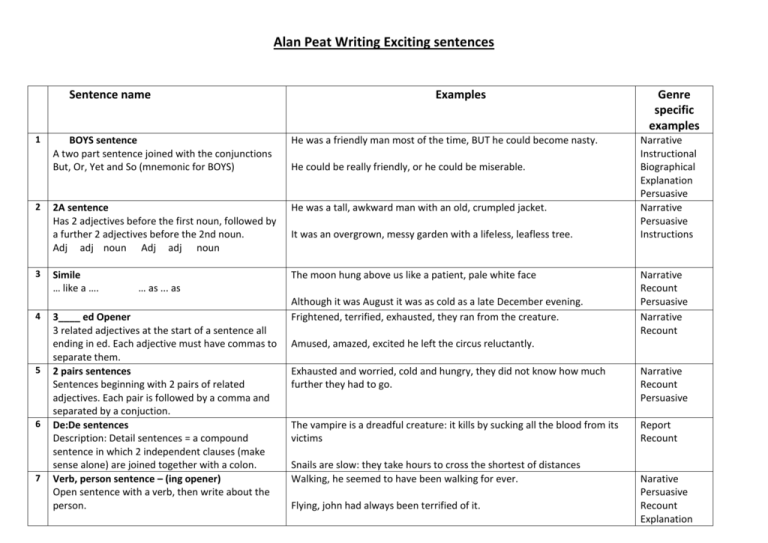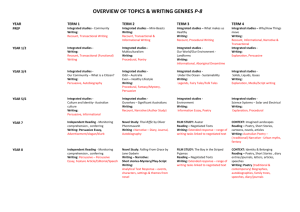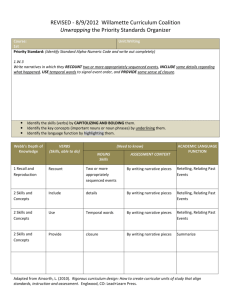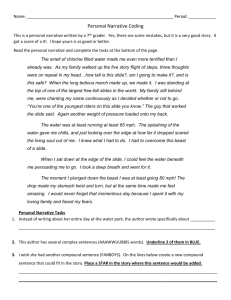Alan Peat Writing Exciting sentences
advertisement

Alan Peat Writing Exciting sentences Sentence name 1 2 3 4 5 6 7 Examples BOYS sentence A two part sentence joined with the conjunctions But, Or, Yet and So (mnemonic for BOYS) He was a friendly man most of the time, BUT he could become nasty. 2A sentence Has 2 adjectives before the first noun, followed by a further 2 adjectives before the 2nd noun. Adj adj noun Adj adj noun He was a tall, awkward man with an old, crumpled jacket. Simile … like a …. The moon hung above us like a patient, pale white face He could be really friendly, or he could be miserable. It was an overgrown, messy garden with a lifeless, leafless tree. … as ... as 3____ ed Opener 3 related adjectives at the start of a sentence all ending in ed. Each adjective must have commas to separate them. 2 pairs sentences Sentences beginning with 2 pairs of related adjectives. Each pair is followed by a comma and separated by a conjuction. De:De sentences Description: Detail sentences = a compound sentence in which 2 independent clauses (make sense alone) are joined together with a colon. Verb, person sentence – (ing opener) Open sentence with a verb, then write about the person. Although it was August it was as cold as a late December evening. Frightened, terrified, exhausted, they ran from the creature. Genre specific examples Narrative Instructional Biographical Explanation Persuasive Narrative Persuasive Instructions Narrative Recount Persuasive Narrative Recount Amused, amazed, excited he left the circus reluctantly. Exhausted and worried, cold and hungry, they did not know how much further they had to go. Narrative Recount Persuasive The vampire is a dreadful creature: it kills by sucking all the blood from its victims Report Recount Snails are slow: they take hours to cross the shortest of distances Walking, he seemed to have been walking for ever. Flying, john had always been terrified of it. Narative Persuasive Recount Explanation 8 9 O. (I.) sentence Outside (Inside) sentence. Made up of 2 related sentences. The first tells the reader what a character is supposedly thinking and shows what is happening on the outside – the characters reaction. The second related sentence, which is placed in brackets, lets the reader know the character’s true inner feelings. She told the little girl not to be so naughty. (Inside, however, she was secretly amused by what she had done.) If, if, if, then sentence A good way of starting or ending a story If the alarm had gone off, if the bus had been on time, if the road repairs had been completed, then his day would not have got off to such a bad start. 10 Emotion word , comma Adjective which describes someone’s feelings, followed by a comma and then more information about the opening emotive adjective. 11 Noun, which/who/ where sentences – ‘drop in’ Narrative Report He laughed heartily at the joke he had been told. (at the same time it would be true to say he was quite embarrassed.) If Hannibal hadn’t lost, if Rome hadn’t won, if Carthage hadn’t fallen then the Mediterranean would be very different today. Terrified, he froze instantly on the spot where he stood. Narrative Discussion Persuasive Recount Narrative Recount Desperate, she screamed for help. Cakes, which taste fantastic, are not so good for your health. sentence Example of a sentence with an embedded clause, it Snakes, which scare me, are not always poisonous. begins with a noun, followed by a comma and an embedded clause which uses who/which/were to begin it, the final part of the sentence adds detail to the opening. 12 Many Questions Where is the treasure? the diamonds? the rubies? the gold? Usually begins with one of the following (Who, what, when, where, why, how of what if) then an What if it rained? it poured? it thundered? it became stormy? initial question ending with a ?, followed by further phrases (or even single words)which in themselves pose additional, related questions. Each of these additional related words /phrases is concluded with a question mark. Capital letters are not used for these. Recount Narrative Explanation Narative Persuasive Recount 13 Ad, same ad 14 15 16 17 Contains two identical adjectives, one repeated shortly after the other. The first use of the adjective is in the opening clause, the second comes directly after the comma. 3 bad – (dash) question Begins with 3 negative adjectives, the first and second adjectives are followed by a comma. The third is followed by a dash, then a question which relates to the 3 adjectives. Double ‘ly’ sentence Ends with 2 adverbs of manner which are joined with the word ‘and’. The first part of the sentence ends with a verb. All the W’s Short sentences which begin with: Who? What? When? Where? Why? Would? Will? What if? List It has no less than three and no more than four adjectives before the noun. 18 Some; others Compound sentence which begins with the word ‘Some’ and has a semi-colon rather than a conjunction which separates it from the 2nd half which begins with the word others. 19 Personification of weather An element of the weather is given a human attribute. 20 P.C (paired conjuctions) 21 The more, the more Example of a paired sentence, the first more He was a fast runner, fast because he needed to be. Narrative Persuasive He was a smart dresser, smart because he had the money to buy the best. Greed, jealousy, hatred – which of these was John Brown’s worst trait? Incompetence, arrogance, stupidity – which of these was Jack’s fatal flaw? He swam slowly and falteringly. Verb 1st adverb 2nd adverb He rode determinedly and swiftly. What next? Why did he run away? It was a dark, long, leafy, lane. It was a cold, wet, miserable and misty morning. Some people love football; others just can’t stand it. Some days are full of enjoyment; others begin and end terribly. The rain wept down the window. The wind screamed through the branches. It was both cold and unpleasant for him to work there. It was not so much lack of time as fear that stopped him from taking the job. The more upset she was, the more her tears flowed. The more happy she became, the more talkative she seemed to be. Narrative Persuasive Report Narrative Instruction Recount Narrative Recount Persuasive Narrative Recount Explanation Narrative Report Recount Persuasive Narrative Recount Narrative Recount Explanation Narrative Instruction should be followed by an emotive word and the second more should be followed by an actio n related to the emotion. 22 Short One, two or three words. Can be used for dramatic effect. Persuasive Discussion Then it happened. Narrative Persuasive Everything failed. 23 __________ ing, _______ ed Always begins with a Walking near the bush, she stopped at the sight of the crocodile facing her. verb ending in ‘ing’ and is followed by the location of the action and then a comma. 24 Irony Overstates how good or bad something is. Running near the beach, he halted as the ground gave way. Our ‘luxury’ hotel tuned out to be a farm building. Narrative Recount Narrative The ‘trip f our dreams’ was, in fact, our worst nightmare. 25 Imagine 3 examples s entences begin with the word imagine and then describe 3 elements of something, the first two are separated by a comma, the third concludes with a colon. The writer then explains that such a time /place exists. Imagine a time when people were not afraid, when life was much simpler, when everyone helped each other: this is the story of that time. Imagine a place where the sun shines, where wars ever happen, where noone ever dies: in the Andromeda 5 system, there is such a planet. Narrative Persuasive







